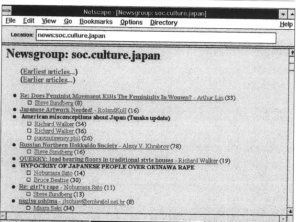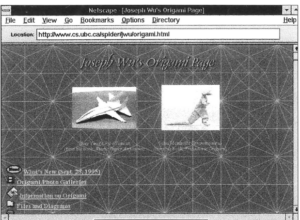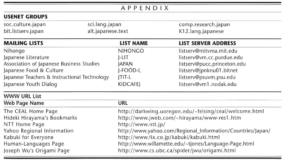
It was only a few years ago that the Internet was solely the domain of scientists, academics, and others wishing to exchange often arcane information with others in their community. No longer is this so; the Internet, long unknown to the general public, has made inroads into virtually every area of our lives, and with the emergence of the World Wide Web, commerce and industry have begun to take advantage of this powerful form of communication. In this context, too, the sites on the Internet where one can learn about Japan have proliferated and are offering information of almost unlimited variety.
Most members of a university faculty have easy access to the Internet. It is only during the last few years, however, that those outside the university are able to join the Internet. There are commercial services such as America Online, Prodigy, CompuServe, or the growing number of Internet providers like NetCom or PSI, so that anyone with a computer and a modem can be part of the Internet.
This article will focus on information about Japan on the Internet. Never before has there been so much information available via the computer in one’s home or office, and consequently, there is now a bounty of information about Japan that one can easily access through the Internet. Because of this abundance of information, we will only deal with Internet newsgroups, mailing lists, gopher searches, and the World Wide Web, omitting features such as Internet Relay Chat (IRC), Telnet, and File Transfer Protocol (FTP).
Usenet Groups
The Usenet consists of thousands of quasi bulletin boards, or newsgroups, each focusing on a theme of common interest. In a Usenet group one can both read what others are saying and post one’s own messages or queries.
There are two major newsgroups about Japan: soc.culture.japan and sci.lang.japan. The soc.culture.japan newsgroup has postings on a large range of topics and lively, often frank, exchanges. It is defined as the newsgroup about everything Japanese except language. A random look at this news-group found 1700 listings in a two-week period with topics such as Kodak vs. Fuji, How well did Reischauer speak Japanese (23 messages), Inter-racial marriages, Any Japanese bicyclists? No apology for WWII, and Trade War—Japanese version (17 messages).
The newsgroup sci.lang.japan focuses on the Japanese language, both spoken and written. A review of this newsgroup found 398 postings in two weeks on subjects which included: Use of anata; shouwa, showa, shoowa . . . (23 messages), Why Americans can’t speak Japanese, Japanese word processing program, and Karaoke songs in roomaji.
There are other less active Usenet groups about Japan such as comp.research.japan, bit.listserv.japan, alt.japanese.text, and K12.1ang.japanese. New Usenet groups are added with great frequency, especially in times of urgency, as for example with the newsgroup established after the Kobe earthquake. (The list of Usenet groups appears in the appendix.)

Mailing Lists
A mailing list is similar to a newsgroup in that it brings together those who are interested in a specific, narrowly-defined subject. Like a newsgroup, people post messages, questions and responses. Unlike a newsgroup, a mailing list consists of a series of postings that are gathered periodically and mailed to its subscribers. This allows the subscriber to read the messages off-line and to lower the cost of telephone and on-line charges. Some mailing lists are moderated, which means that someone is reviewing the postings and winnowing out those messages that do not adhere to the list’s guidelines.
Mailing lists have two addresses: one that is used to subscribe to the list (or to unsubscribe or suspend receipt of the list) and another address to which one sends postings. We will include only the subscription address here since the posting address is supplied by the list server upon receiving a subscription notice. For those unfamiliar with the procedure to be used in subscribing, it is as follows: You send e-mail to the list server’s address, leave the subject line blank and include in the body of the message SUBSCRIBE list name your real name. So if Jane Doe were subscribing to the mailing list JLIT-L, her message would read: SUBSCRIBE JLIT-L Jane Doe.
A fairly active mailing list called Nihongo is usually mailed several times a week and includes postings on language related issues such as the Jorden methods, reading Japanese on the Internet, job searches, translation assistance.
There are also mailing lists devoted to Japanese literature, to teaching Japanese, to Japanese business, and to connections between youngsters. (The list server addresses for mailing lists about Japan will be noted in the appendix.)
Gopher Searches
A Gopher search is a tool that uses a keyword, such as Japanese, to search for titles of files in a database. If any title is of interest, the file can be downloaded and added to one’s own database. There are several very large gopher sites at universities such as Carnegie-Mellon, North Carolina (Sunsite), and the University of Minnesota. The Library of Congress also has a large database, MARVEL, that can be accessed through the Internet. Providers of Internet services will usually have software for doing gopher searches at some or all of the gopher sites.
A search of the gopher titles at the University of Minnesota (for example) with the keyword Japanese yielded eight pages of titles; they ranged from Japanese Language Kit: Overview to The Japanese forest industry to Epidemiology of Japanese encephalitis. Similar searches at other sites would also yield numerous useful files.
One has to choose keywords that are neither too broad nor too narrow in scope in order to be able to cull the needed information. For example, a keyword such as Japan would be too broad since there could be thousands of titles appropriate to this entry.
World Wide Web
The World Wide Web (WWW) adds a multimedia aspect to the Internet that enables browsers to see graphics, video, and text, as well as hear sound. The Web is organized around the concept of “pages” floating in cyberspace, pages that are interconnected by links, permitting readers to proceed in their own unique fashion, by following whichever links hold interest for them.
There are so many WWW sites about Japan that listing them here would be cumbersome. Instead, the sites that have many links to other Japan-related sites are listed, and in this way, one can gain access to most Web sites dealing with Japan. Thus, for example, instead of referring to the excellent Web pages of the National Clearinghouse for U.S.-Japan Studies or that of the AAS, we will list the WWW page of the CEAL which in addition to information about CEAL has links to the pages of other organizations including AAS and the National Clearinghouse. In addition to these all-inclusive sites, other unique and informative WWW sites are noted. (The URL — universal resource locator, equivalent to a WWW address — for all cited WWW pages will appear in the appendix.)
If one looks at the CEAL Web page, the richness of the resources is seen immediately; one can choose to look at information about accessing Japanese character text on the Internet and will find more than ten documents dealing with the display of text in Japanese. The section on East Asian programs subsumes information on the National Clearing¬house, the Stanford Japan Center, and other organizations with connections to Asia. Another section on resources in Japan has tools such as telephone codes and lists of publishers. There is a listing of Internet sites in Japan,as well as a sec-tion on electronic documents about Japan which are organized by subject area, beginning with Art.
Another Web page that contains an enor¬mous number of links to other pages about Japan (as well as useful Internet sources) is one put together by Hideki Hirayama, a university student. Despite the frequent typos, this list is very useful because of its links. The Web pages are arranged by Hirayama in grouped sections such as Indexes, Communications, Educational Institutions, Entertainment, Japanese Government, and Japanese Information.
The NTT Home Page has information on Japan including its geography, customs, sports, and the law, as well as links to other pages like Stanford University’s Japan Window. The index known as Yahoo, which provides thousands of Web pages by topic, has a section on Regional Infor-mation. Here one can find a large inven-tory of WWW sites pertaining to Japan.
The page Kabuki for Everyone has the monthly program for Kabuki-za with summaries; there are also illustrations and the sounds of kabuki. The Human Lan¬guages page includes a lengthy section on Japanese, including a Japanese-English dictionary. (Scroll down to Quick Jump and click on the letter J.) Joseph Wu’s Origami page gives information on the history of origami, a how-to section, a list of origami associations and a very com-prehensive list of links to other origami web sites. (See Figure #2.)
From newsgroups to the World Wide Web, the places on the Internet that provide information and assistance about Japan are plentiful. With only a few keystrokes and some intellectual curios-ity, one can discover new and fascinating realms.


